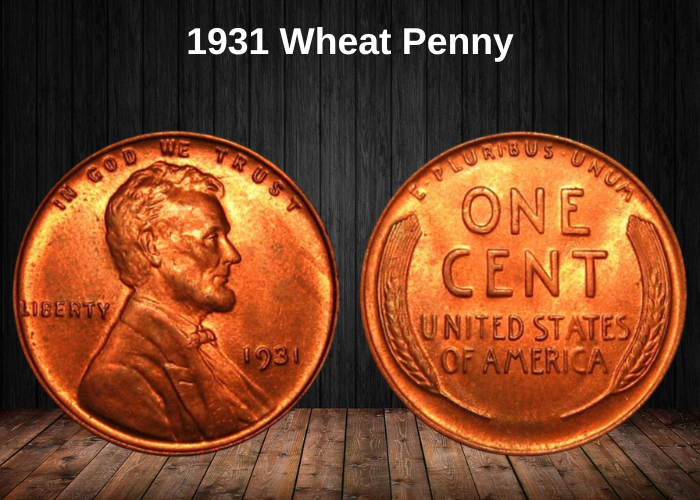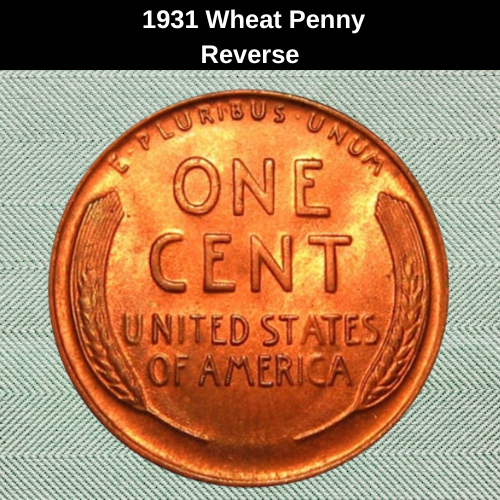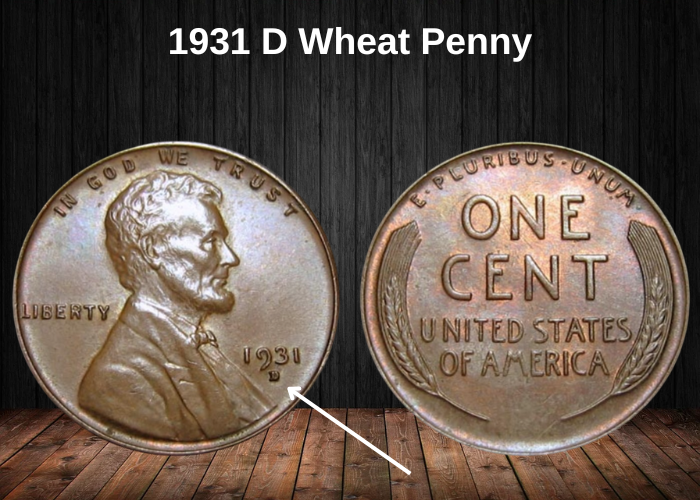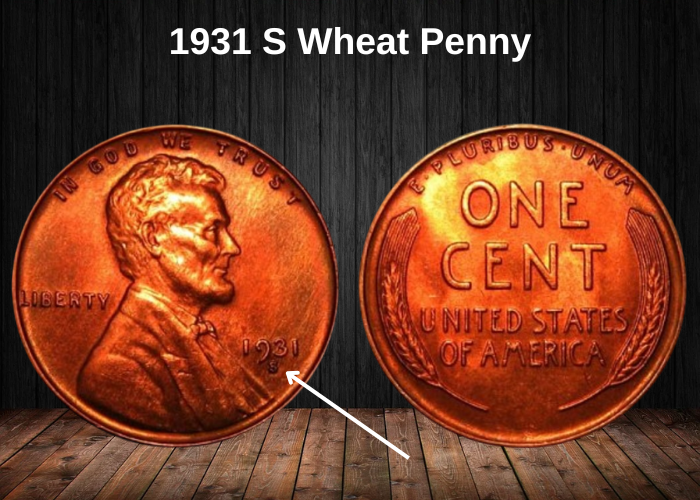The 1931 Wheat Penny, a coin that holds significant appeal for numismatists, was minted during a critical period in American history: the Great Depression. This coin is not only a symbol of the era but also a sought-after item for coin collectors, especially those who focus on errors, mint marks, and unique characteristics. Below is an in-depth exploration of the 1931 Wheat Penny, including its history, variations, value, grading, and errors.
1931 Wheat Penny Value Chart (Brown Coins)
The value of a 1931 Wheat Penny depends on several factors, including the mint mark, condition, and any notable errors. Below is a general value guide for the 1931 Wheat Penny in brown condition (worn, circulated coins). These values are based on the coin’s appearance and do not account for rare errors or higher grades, which can fetch much higher prices.
- No Mint Mark (Philadelphia):
- Good (G-4): $0.50 – $1.00
- Fine (F-12): $1.00 – $3.00
- Very Fine (VF-20): $2.50 – $5.00
- Extremely Fine (EF-40): $5.00 – $10.00
- Uncirculated (MS-60): $25.00 – $50.00
- D Mint Mark (Denver):
- Good (G-4): $0.75 – $1.50
- Fine (F-12): $1.50 – $3.00
- Very Fine (VF-20): $3.00 – $6.00
- Extremely Fine (EF-40): $6.00 – $12.00
- Uncirculated (MS-60): $30.00 – $60.00
- S Mint Mark (San Francisco):
- Good (G-4): $0.75 – $1.50
- Fine (F-12): $1.50 – $3.00
- Very Fine (VF-20): $3.00 – $6.00
- Extremely Fine (EF-40): $6.00 – $12.00
- Uncirculated (MS-60): $30.00 – $60.00
The values above represent typical values for coins that are not in the highest condition (such as Uncirculated or MS-60). Coins that have been preserved in higher grades, particularly MS-65 or above, can sell for much higher prices. Also, coins with rare errors can significantly increase in value, as discussed later.
History of the 1931 Wheat Penny

The 1931 Wheat Penny was minted during the height of the Great Depression. At the time, the United States was dealing with extreme economic difficulties. Unemployment was rampant, and the government was looking for ways to stimulate the economy. The 1931 Wheat Penny was part of a series of coins that saw limited mintage due to budget constraints at the U.S. Mint.
Despite being a Depression-era coin, the 1931 Wheat Penny became a symbol of perseverance. The coin’s design, which features Abraham Lincoln on the obverse and two stalks of wheat on the reverse, reflects the agricultural roots of America, as well as its enduring commitment to the values of liberty and unity.
1931 Wheat Penny Types
There are three primary types of 1931 Wheat Pennies, determined by their mint marks. These are:
- No Mint Mark: Minted in Philadelphia
- D Mint Mark: Minted in Denver
- S Mint Mark: Minted in San Francisco
Each of these types has different mintage figures, which contributes to their rarity and value. The Philadelphia mint is the most common, while the Denver and San Francisco coins tend to be rarer.
Features of the 1931 Wheat Penny
The 1931 Wheat Penny is quite distinct, with several key features that set it apart from other coins of the time. These features include:
- Obverse: The obverse (front) of the coin displays a detailed portrait of Abraham Lincoln, created by engraver Victor D. Brenner. The inscription “IN GOD WE TRUST” is seen above his head, while “LIBERTY” is inscribed to the left and the year “1931” to the right.
- Reverse: The reverse of the coin features two stalks of wheat, symbolizing the agricultural background of the United States. The words “UNITED STATES OF AMERICA” are engraved along the top, with “E PLURIBUS UNUM” at the bottom. The denomination “ONE CENT” is prominently displayed in the center.
The Obverse of the 1931 Wheat Penny

The obverse of the 1931 Wheat Penny is dominated by Abraham Lincoln’s profile. This design, which was created by Victor D. Brenner, became iconic and is one of the most recognizable coin designs in the United States. Lincoln’s face is highly detailed, with his features sharply defined. The coin’s inscriptions are also clear, reflecting the high quality of engraving and minting at the time.
The Reverse of the 1931 Wheat Penny

The reverse of the coin is characterized by the two stalks of wheat that give the coin its name. The wheat stalks are elegantly detailed, and the phrase “UNITED STATES OF AMERICA” arches above the wheat. Below the stalks is the inscription “E PLURIBUS UNUM,” which translates to “Out of many, one.” The denomination “ONE CENT” is centered on the reverse, with a bold font to make the value clear.
1931 Wheat Penny Details
- Weight: 3.11 grams
- Diameter: 19 mm
- Composition: 95% copper, 5% tin and zinc
- Edge: Plain (no ridges)
- Designer: Victor D. Brenner
- Mint Marks: D (Denver), S (San Francisco), or no mint mark (Philadelphia)
These details are consistent across the series of Wheat Pennies, but each coin can vary depending on the minting process and wear over time.
Other Features of the 1931 Wheat Penny
In addition to the prominent design features, the 1931 Wheat Penny stands out because of its relatively low mintage numbers. This has contributed to its increased demand among collectors. Furthermore, coins from the Great Depression era often hold historical value, as they serve as a reminder of the economic struggles of the time.
1931 Wheat Penny Grading Guides
The value of a 1931 Wheat Penny also depends on its grade. Coins are graded on a scale from Poor (P-1) to Mint State (MS-70). Here are the general guidelines for grading Wheat Pennies:
- Good (G-4): The coin shows significant wear, but all major features are visible. The details of Lincoln’s portrait and the wheat stalks may be worn but still discernible.
- Fine (F-12): The coin has moderate wear, and the design is visible but less detailed. The coin may have slight smoothing of the features.
- Very Fine (VF-20): The coin shows light wear, but the major design elements are sharp and easily identifiable. Lincoln’s face and the wheat stalks are well-defined.
- Extremely Fine (EF-40): The coin shows minimal wear with almost no detail loss. Lincoln’s portrait and the wheat stalks retain sharpness.
- Uncirculated (MS-60 to MS-70): The coin is free from wear, and its design features are crisp. Higher grades (MS-65 or above) are considered gem-quality and are highly sought after.
1931 Wheat Penny Value Guides
Depending on its condition, a 1931 Wheat Penny can be worth anywhere from a few cents to hundreds of dollars. Coins in the highest grades, particularly those with unique errors or exceptional preservation, can be worth significantly more. The following value guide reflects typical prices for each grade:
- Good (G-4): $0.50 – $1.00
- Fine (F-12): $1.00 – $3.00
- Very Fine (VF-20): $2.50 – $5.00
- Extremely Fine (EF-40): $5.00 – $10.00
- Uncirculated (MS-60 to MS-70): $25.00 – $50.00 (higher for MS-65 and above)
1931 No Mint Mark Wheat Penny Value
The 1931 Wheat Penny with no mint mark, struck in Philadelphia, is the most common version of the coin. It generally has lower values compared to the D and S mint mark varieties, but it still holds value, especially in higher grades. A 1931 no mint mark penny in excellent condition can be worth upwards of $50, while those in poor condition are still valued at around $0.50 – $1.
1931 D Wheat Penny Value

The 1931 D Wheat Penny, minted in Denver, is rarer than its Philadelphia counterpart. This rarity contributes to its higher value. In higher grades, a 1931 D Wheat Penny can be worth up to $60 or more, depending on its condition. This coin is particularly sought after by collectors of rare U.S. coins.
1931 S Wheat Penny Value

The 1931 S Wheat Penny, minted in San Francisco, is often considered one of the rarer varieties of the 1931 Wheat Penny. As with the 1931 D version, the scarcity of the 1931 S adds to its value, especially in higher grades. A well-preserved 1931 S penny can fetch up to $60 or higher, depending on its specific features.
Rare 1931 Wheat Penny Errors List
Certain errors in the minting process make the 1931 Wheat Penny even more valuable. These errors are highly prized by collectors and can add significant value to a coin. Some of the most sought-after errors include:
- Double Die Errors: The most famous type of error, where the design appears twice due to a misalignment in the die.
- Off-Center Strikes: When the coin is not properly aligned with the press, causing the design to be partially struck off-center.
- Die Cracks: A crack in the die that leads to a raised line on the coin’s surface.
- Repunched Mint Marks: When the mint mark is mistakenly punched into the die more than once, leading to a double or triple mint mark.
- Clipped Planchets: Coins that were accidentally struck on a blank piece of metal with a portion missing, leaving a clip in the coin’s edge.
Coins with these types of errors can be worth significantly more than a typical 1931 Wheat Penny, depending on the type and severity of the error.
The 1931 Wheat Penny is a highly collectible coin that appeals to both novice and experienced collectors. Its value is influenced by factors like mint mark, condition, and errors, making it a coin with great potential for those willing to invest time into understanding its nuances. Whether you’re a beginner or an advanced collector, the 1931 Wheat Penny offers something of value, especially in terms of its historical significance and the possibility of finding rare, error-filled examples.
Where to sell your penny?
Now that you know the value of your penny, you might be wondering where to sell it. Don’t worry: here’s a guide to some of the best online platforms where you can easily sell your coins, along with their advantages and disadvantages.
Discover the best platforms for selling coins online (pros and cons).
FAQ
1. Why is the 1931 Wheat Penny considered one of the more significant coins from the early 1930s?
The 1931 Wheat Penny is historically important because it was minted during the depths of the Great Depression. Coin production had slowed significantly, and the 1931 penny marked a year of economic struggle for the United States. This period of low mintage, combined with the penny’s historical context, makes the coin a significant symbol of the era, especially considering the harsh conditions of the Depression.
2. How does the mintage of the 1931 Wheat Penny compare to other years in the Wheat Cent series?
The total mintage of the 1931 Wheat Penny was 164,400,000, which is fairly high, though it is still lower than some other years in the 1920s. The 1931 penny was produced in three locations: Philadelphia, Denver, and San Francisco. The relatively higher mintage, combined with economic constraints during the Depression, makes finding high-grade examples particularly rare, adding value to well-preserved specimens.
3. What makes the 1931-S Wheat Penny particularly rare compared to other 1931 pennies?
The 1931-S Wheat Penny had a relatively low mintage of just 866,000 coins, making it much rarer than the 1931 Philadelphia and 1931-D issues. Because of its low mintage, the 1931-S is highly sought after by collectors, and coins in higher grades, especially MS64 or higher, can command a premium. The rarity and the demand for well-preserved examples contribute to the 1931-S’s higher market value.
4. How does the condition of a 1931 Wheat Penny impact its desirability and value?
As with most coins, the condition of a 1931 Wheat Penny plays a significant role in determining its value. Coins in uncirculated condition, especially those graded MS64 or higher, are much more valuable. The 1931-S penny, in particular, is extremely rare in uncirculated grades, so any well-preserved specimens can fetch a much higher price than those in lower grades. Coins that retain their red (RD) color are also more desirable compared to those with brown (BN) or red-brown (RB) toning.
5. Are there any known die varieties or errors in the 1931 Wheat Penny series that collectors should look out for?
While the 1931 Wheat Penny is not known for major varieties or errors, collectors occasionally find die cracks, double die errors, or off-center strikes in these coins. These imperfections, though not widespread, can make specific coins more valuable, especially when found in high grades. As with other years in the Wheat Cent series, minor variations can sometimes add to the appeal of these pennies for error collectors.
6. Why is the 1931-S Wheat Penny considered one of the most valuable in the series?
The 1931-S Wheat Penny is highly valued primarily due to its low mintage and rarity. Only 866,000 coins were minted at the San Francisco Mint, which makes it one of the rarest coins in the Wheat Cent series. In high grades, particularly MS64 or MS65, this coin can command a significant premium, making it one of the top rarities among the Wheat Pennies, sought after by both collectors and investors.
7. What is the long-term investment potential for the 1931 Wheat Penny, and which variety has the best chance for appreciation?
The 1931-S Wheat Penny holds the most investment potential due to its low mintage and rarity in higher grades. As demand for well-preserved coins increases, the value of 1931-S coins in MS64 or higher, especially those with red (RD) designation, is likely to appreciate over time. Given the scarcity and the historical significance of the coin, collectors may see substantial returns on investment as the supply of uncirculated coins continues to decrease.



















































